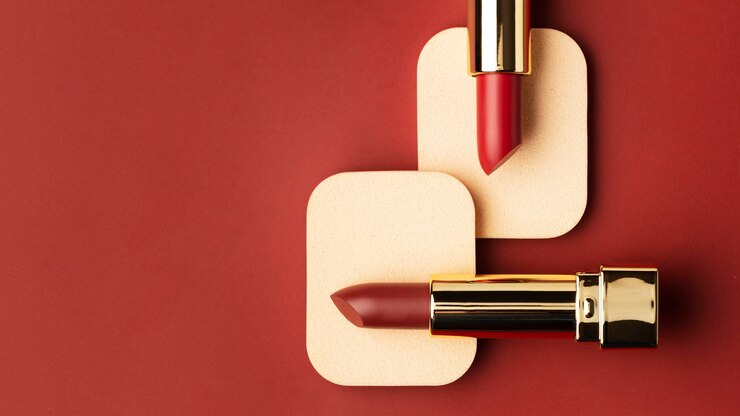Lipstick, a quintessential beauty product, has adorned the lips of individuals throughout centuries, leaving an indelible mark on the landscape of glamour. From ancient rituals to modern runways, the history of lipstick is a captivating journey that weaves through cultures, trends, and societal shifts. Join us as we trace the evolution of this cosmetic marvel, exploring its origins, symbolic significance, and transformation into a symbol of empowerment and self-expression.
- Ancient Beginnings: Mesopotamia and Egypt (3500 B.C. – 1000 B.C.):
Ingredients: Crushed gemstones, insects, and natural dyes.
Symbolism: Sign of social status and religious rituals.
Explanation: The origins of lipstick can be traced back to ancient civilizations like Mesopotamia and Egypt, where both men and women adorned their lips with lip color created from crushed gemstones, insects, and natural dyes. Lipstick held symbolic importance, representing social status and playing a role in religious ceremonies. - Greece and Rome (500 B.C. – 476 A.D.):
Ingredients: Red dyes, plant extracts, and beeswax.
Symbolism: Associated with prostitutes and theater performers.
Explanation: In ancient Greece and Rome, lipstick took on a different connotation. It became linked with specific professions, such as prostitutes and theater performers, leading to both admiration and controversy. The formulation evolved, incorporating red dyes, plant extracts, and beeswax. - Medieval Europe (500 A.D. – 1500 A.D.):
Status: Lipstick use declines, associated with impropriety.
Explanation: In medieval Europe, lipstick faced a decline in popularity. It was linked to notions of impropriety, and the Church condemned its use. The stigma surrounding lipstick persisted, contributing to a period where its usage waned. - Renaissance (14th – 17th Century):
Revival: Lipstick sees a resurgence among European nobility.
Explanation: The Renaissance marked a revival of interest in cosmetics, including lipstick. European nobility embraced the use of lip color, and new formulations emerged, often featuring vibrant red and berry hues. - 19th Century: The Rise of Lip Rouge:
Ingredients: Carmine dye, beeswax, and castor oil.
Explanation: The 19th century witnessed the rise of lip rouge, a precursor to modern lipstick. Carmine dye, made from cochineal insects, became a popular ingredient, blended with beeswax and castor oil. Queen Victoria herself was said to be a fan of lip rouge. - Early 20th Century: The Birth of Modern Lipstick:
Innovation: Maurice Levy invents the first metal lipstick container.
Explanation: The early 20th century saw the invention of the first metal lipstick container by Maurice Levy. This innovation marked a shift towards the modern lipstick we know today, with formulations becoming more refined and accessible. - 1920s – The Jazz Age: Lipstick as a Symbol of Liberation:
Culture: Lipstick becomes a symbol of rebellion and freedom.
Explanation: The Roaring Twenties witnessed a cultural revolution, and lipstick became a symbol of women’s liberation. Dark, bold shades gained popularity, reflecting the spirit of the Jazz Age. - 1940s – World War II: Lipstick as a Morale Booster:
Culture: Lipstick becomes a symbol of resilience and morale.
Explanation: During World War II, lipstick took on a new role. Many women saw it as a small luxury and morale booster during challenging times. The iconic red lip became synonymous with strength and resilience. - 1950s – Hollywood Glamour: Iconic Red Lips Take Center Stage:
Culture: Marilyn Monroe popularizes the red lip.
Explanation: The 1950s saw Hollywood glamour influencing beauty trends. Marilyn Monroe, with her iconic red lips, became a symbol of sensuality and femininity, contributing to the enduring popularity of the red lip. - Late 20th Century – Present: Empowerment and Self-Expression:
Culture: Lipstick becomes a tool for self-expression.
Explanation: In the late 20th century and beyond, lipstick evolved into a powerful tool for self-expression. It transcended traditional beauty standards, with diverse shades and formulations catering to a wide range of preferences. Lipstick became a symbol of empowerment and individuality.
The history of lipstick is a rich tapestry, woven with threads of symbolism, cultural shifts, and individual expressions of beauty. From its ancient origins to its role in modern empowerment, lipstick has stood the test of time as a symbol of glamour, rebellion, and self-expression. As we continue to explore new horizons in beauty, the journey of lipstick unfolds, leaving an indelible mark on the canvas of human adornment.








